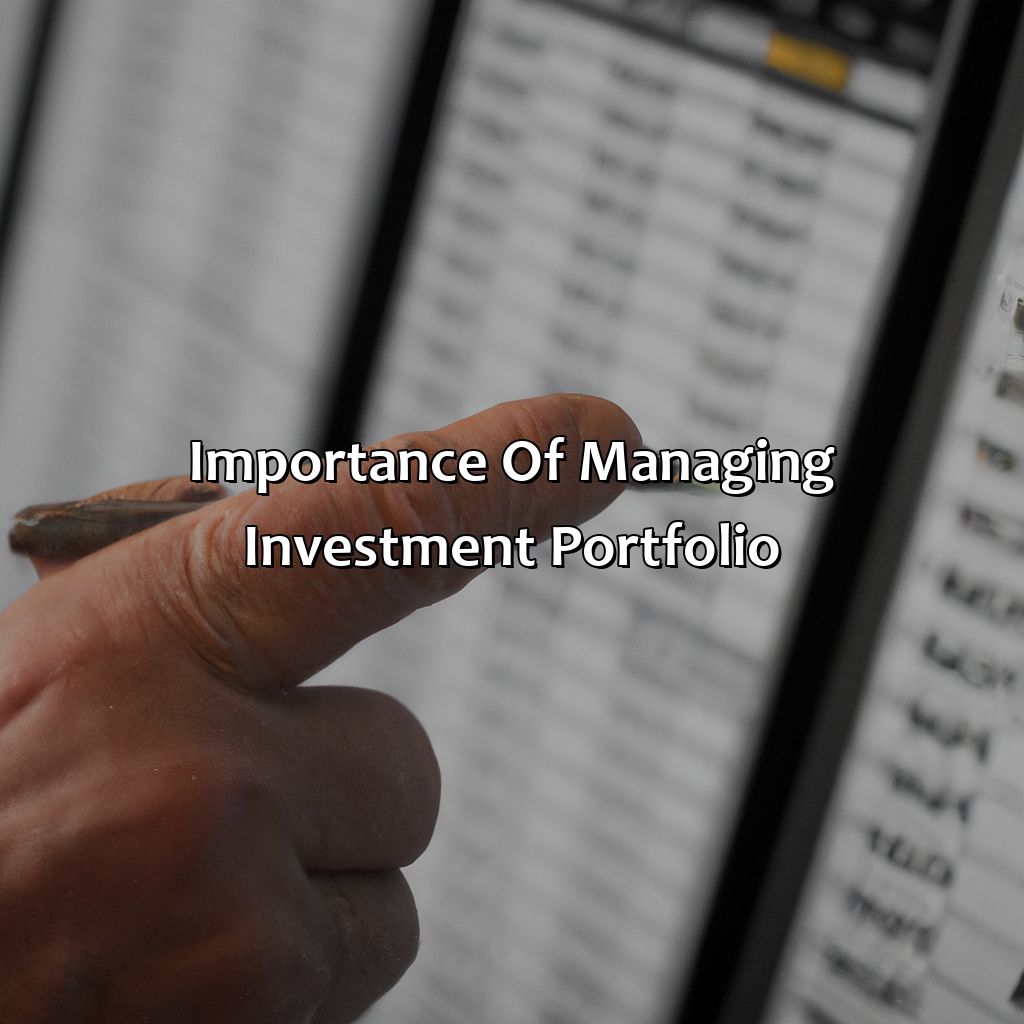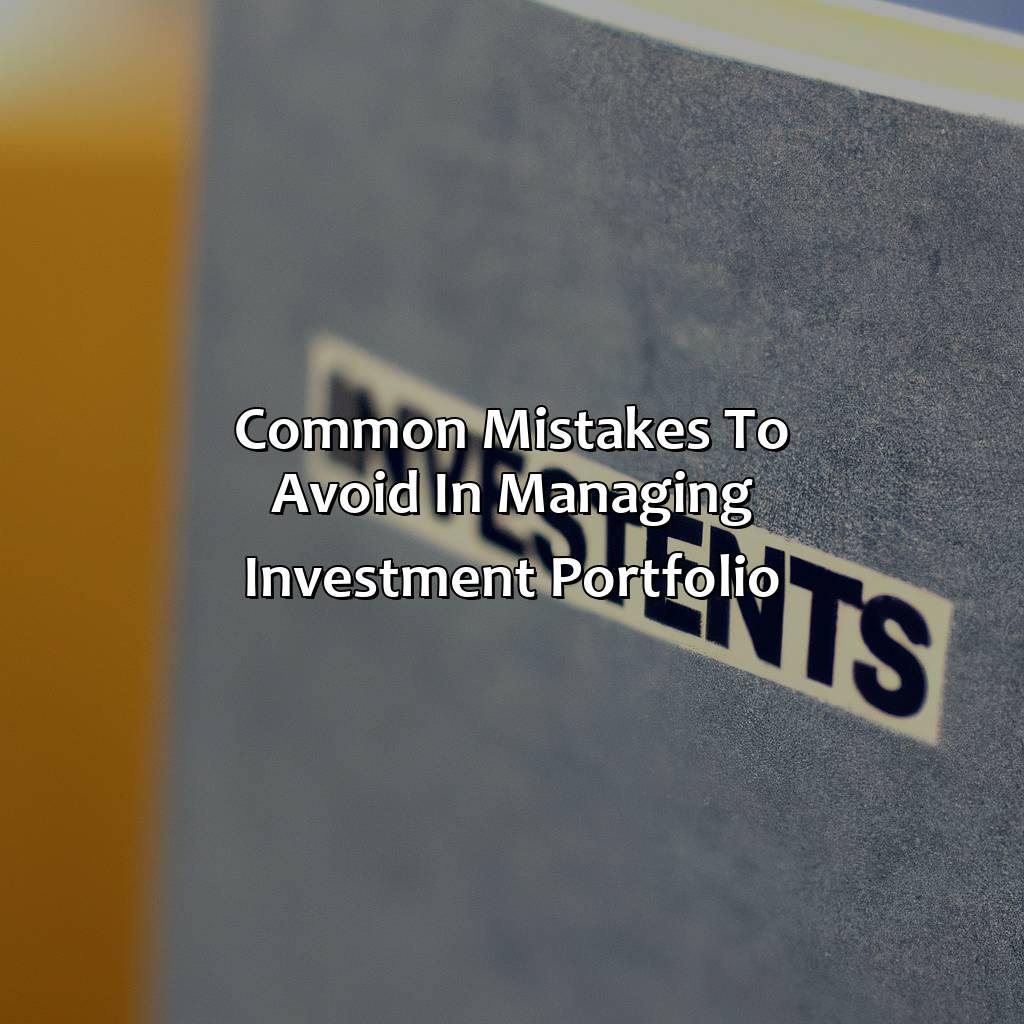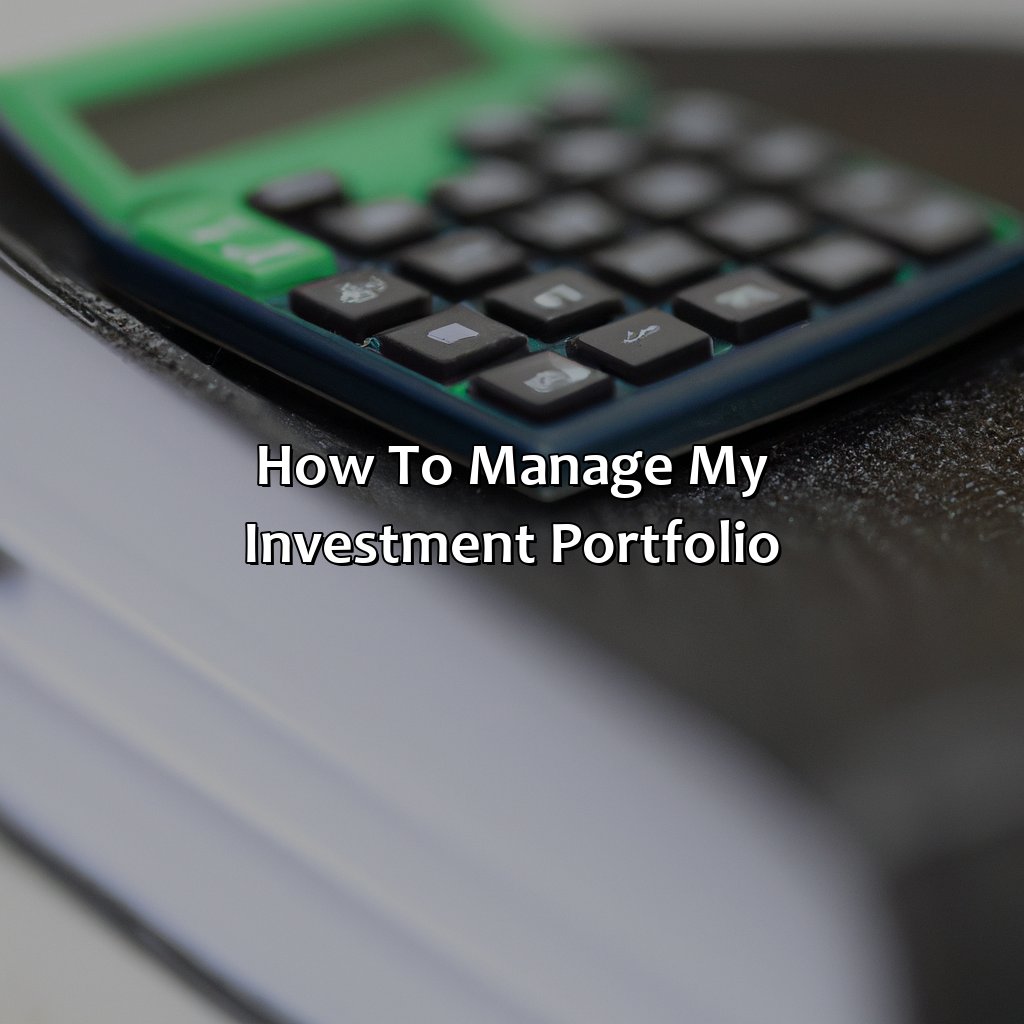How To Manage My Investment Portfolio?
Key Takeaway:
- Managing your investment portfolio is important to achieve long-term financial goals. It helps to prioritize your investment options, assess risk and returns, and manage the impact of taxes.
- To manage your investment portfolio, it is important to set clear investment goals, determine your asset allocation, and diversify your portfolio across different investment options to manage risk.
- There are different strategies to manage your investment portfolio, including choosing between active or passive investing, value or growth investing, and long-term or short-term investments. It is important to consider your risk tolerance and investment goals before selecting these strategies.
- Mistakes to avoid in managing your investment portfolio include making hasty investment decisions, failing to rebalance your portfolio regularly, and not monitoring your investments closely. It is crucial to be patient, disciplined, and proactive when managing your investment portfolio.
Are you feeling overwhelmed managing your investment portfolio? Don’t fret! We’ve got you covered with this quick guide on how to make the most of your investments. With our expert advice, you can confidently manage your portfolio and enjoy the rewards.
Importance of managing investment portfolio
Managing your investment portfolio is crucial to achieving long-term financial stability. Diligent monitoring and analyzing of your assets can help mitigate risk and increase returns. By diversifying your holdings, rebalancing periodically, and staying informed of market trends, you can optimize your portfolio for maximum performance. Additionally, regularly checking in on your investments can provide valuable insight into personal financial goals and help make informed decisions about wealth management.
It’s important to note that no single investment strategy is best for everyone, and seeking the guidance of a financial advisor can be beneficial. With their expertise and guidance, you can customize your portfolio to your unique needs and risk tolerance.
According to a recent study by Charles Schwab, those who regularly engage in investment portfolio management tend to have higher account balances and better long-term returns. So, taking the time to manage your portfolio can pay off in the long run.

Image credits: retiregenz.com by Adam Arnold
Steps to manage investment portfolio
Set investment goals first! Then, pick the asset allocation that works for you. Keep diversifying your portfolio. Monitor investments often. Rebalance when needed. Follow these steps for effective management of your investment portfolio and achieving your goals.
- Set investment goals first!
- Pick the asset allocation that works for you.
- Keep diversifying your portfolio.
- Monitor investments often.
- Rebalance when needed.

Image credits: retiregenz.com by Adam Woodhock
Setting investment goals
When creating a roadmap to manage your investments proficiently, evaluating and defining “investment aspirations” can create the basis of any portfolio strategy. Understand how identifying objectives and managing each effectively is vital for augmenting long-term wealth generation.
- Assess your risk appetite: Identify how much risk you are willing to take on an individual investment in your portfolio. This involves determining various factors such as age, investment objectives, current financial situation.
- Delineate your portfolio goals: The next step is determining the investment goals that will shape attainable targets for each asset class in your portfolio. These could range from capital growth to high dividend payments or even a mixture of both.
- Match investments to stated goals: Look at multiple investment options such as stocks/bonds/mutual funds/alternatives and analyze their performance relative to your portfolio targets- assess their strengths and weaknesses in achieving short-term and long-term returns based on growth potential & risk factors
- Continuously assess progress towards meeting goals – Regular monitoring ensures stock prices do not impact the ability of the portfolio with opportunities for refinements where needed.
Ensuring that all steps are executed professionally will assist in managing and tracking necessary changes required while allowing further refinement of goals at a later stage. These measures require time, patience, skill, and consistent tracking; thus seeking professional guidance can prove useful.
According to Vanguard’s latest report on average investor behavior from 2009-2018 shows that investors mostly underperform compared to market benchmarks like S&P 500 due to fear-based decisions like market-timing or low diversification portfolios – leading to missed incentives & making corrective decision-making harder because the losses are already locked-in.
You can’t put all your eggs in one basket, unless that basket is made of solid gold and guarded by dragons.
Asset allocation
Distributing investments among stocks, bonds, and cash equivalents to optimize returns and minimize risk is the fundamental concept of portfolio allocation. It consists of a systematic approach for dividing assets into buckets based on investment goals, time horizon, and risk tolerance levels.
The process involves evaluating the financial state, understanding values, researching options and anticipating future returns. As different asset classes get affected differently by market swings, it’s crucial to strategically balance allocation accordingly.
Asset distribution is adjustable depending on individual circumstances. For instance, younger investors may have more stocks in equity while older investors might have more bonds allocated in the portfolio.
Consider watching investment trends to modify and monitor your investment performance regularly to maximize results. A diversified portfolio containing risky assets can bring high returns but also lead to potential losses.
Investor.gov suggests re-examining asset allocations every year or two whenever there are significant life changes like marriage, children’s birth or job promotions.
According to Forbes’ Brian Menickella: diversifying your investments isn’t shielding from risks but ensuring you are as resilient against any uncertainties that occur in markets.
Putting all your eggs in one basket may make for a tasty omelette, but it’s not a great investment strategy.
Diversification
Investment portfolio diversification is essential in risk management. Holding a variety of assets across different sectors, regions, and asset classes can reduce market volatility and optimize returns. A diversified portfolio should not solely rely on a single investment or market. Instead, it should be well-balanced to create consistency in performance.
Monitoring investments is like being a stalker, but instead of stalking your ex, you’re stalking your money.
Monitoring investments
To keep a watchful eye on your investment portfolio, regular examination and evaluation are essential. It is imperative to use monitoring tools, such as financial market reports and analytics software that provide real-time updates for reliable decision-making.
By keeping tabs on the stock performances of your portfolio, you can take appropriate action by either holding or selling stocks in response to market fluctuations. You may want to employ an automated tracking system that alerts you when your investments reach certain profit or loss levels, enabling you to act promptly. Another way to monitor your investments effectively is by checking news sources that cover industries relevant to your portfolio assets.
Additionally, keeping abreast of regulatory changes and economic policies can help you manage the risks in your investment portfolio appropriately. To this end, engaging with a competent financial advisor can help you navigate these complex issues and make smarter choices for long-term profitability.
“Rebalancing your portfolio is like trimming your bonsai tree – you have to cut back some branches to make it grow stronger.”
Rebalancing portfolio
Maintaining a well-rounded investment portfolio is crucial in achieving financial success. One important aspect of a balanced portfolio is reassessing and adjusting the distribution of assets, commonly referred to as “tuning the bell-curve“. By evaluating the performance and risk of one’s investments, one can identify which areas require attention and which can be left untouched.
It is recommended that an investor rebalances their portfolio at least once per year, or if there are significant market shifts. This process involves selling over-performing assets and buying high-potential ones to ensure a healthy distribution. In doing so, investors reduce their exposure to risky assets and evenly spread their investments.
Furthermore, it is beneficial to maintain consistency in investment strategy and remain disciplined in sticking to a predetermined allocation plan. This approach reduces emotional bias and short-term reactions that are often responsible for poor decision-making.
Investors should also consider any tax implications when managing their portfolios. By strategically allocating gains and losses across multiple accounts, investors can minimize their tax liability while maintaining optimal asset distribution.
In summary, regularly reviewing and adjusting your investment portfolio is critical for effectively managing your investments. By monitoring performance, reallocating assets, staying disciplined to your allocation plan, considering tax implications, investors can attain long-term financial success. Managing your investment portfolio is like playing chess, you need a strategy and plenty of patience to win the game.
Strategies to manage investment portfolio
To manage your investments successfully, you must strategize with contrasting strategies such as active versus passive investing, value versus growth investing, and long-term versus short-term investment. Plus, you can consider investing in stocks, bonds, mutual funds, ETFs, and more. Furthermore, risk management and tax planning could be essential for making smart investment decisions.

Image credits: retiregenz.com by James Jones
Active vs passive investing
Investment strategies: Understanding the differences between Active and Passive investing is crucial in managing your portfolio.
Active vs Passive Investing:
| Active Investing | Passive Investing | |
|---|---|---|
| Definition | Actively selecting stocks | Tracking a market index |
| Management | Requires high involvement and skill | Automated, low-involvement management |
| Cost | High trading fees and expenses | Lower fees and expenses due to automated management |
| Risk | High risk exposure due to individual stock selection | Diversifies risk through broad market tracking |
| Return | Potential for higher returns | Average returns with minimal effort |
It’s essential to note that both approaches have their benefits and drawbacks, so it’s necessary to evaluate your investment goals and risk tolerance before making a decision. Incorporating a combination of both strategies may also be beneficial in diversifying your portfolio.
Don’t miss out on opportunities; ensure you have a well-constructed investment plan tailored to your goals. Seek professional guidance if needed.
If you’re torn between value and growth investing, just remember that one is like buying a vintage car and hoping it appreciates in value, while the other is like getting a car lease and chasing after the latest model.
Value vs Growth investing
Investment: Value Investing vs Growth Investing
Value investing and growth investing are two distinct strategies used by investors while managing their portfolio. Value investing involves finding undervalued stocks that can generate long-term returns. On the other hand, growth investing is focused on finding stocks with high potential for earnings growth that can outperform the market.
While value investors may look for stocks with lower price-to-earnings (P/E) ratios or price-to-book (P/B) ratios, growth investors tend to focus on companies with high revenue or earnings growth rates. These approaches have different risk-return profiles as well; value investing tends to have lower risk but offers more modest returns, while growth investing has a higher amount of risk but can generate higher returns.
It’s important to note that there is no one-size-fits-all approach when it comes to deciding between value and growth investing. Factors such as individual investment goals, time horizon, and risk tolerance should be considered before making any decisions.
In addition to these considerations, it’s also essential to regularly review your investment portfolio and make necessary adjustments based on market conditions and changes in your personal financial goals. Diversifying your investments across various sectors or asset classes can also help reduce overall portfolio risk.
Overall, whether you choose value or growth investing depends on your personal financial goals and investment strategy. By keeping an eye on the market trends and staying informed about new investment opportunities, you can successfully manage your portfolio over the long term.
Long-term investment: like a marriage, choose wisely and commit fully. Short-term investment: like a fling, enjoy the ride but don’t get too attached.
Long-term vs Short-term investment
Investments can be categorized as long-term or short-term. Choosing the right investment strategy is crucial to maximizing returns and minimizing risks.
A long-term investment portfolio aims for stability and growth over several years, while a short-term portfolio comprises investments that are less stable but offer the potential for quick gains.
When considering long-term vs short-term investments, assess your financial goals, risk tolerance, and time horizon. A long-term strategy involves investing in low-risk options such as bonds, stocks, and mutual funds suited to your goals and risk profile. While a short-term approach includes high-risk assets such as cryptocurrency or options trading that require active management.
It’s essential to remember that both long-term and short-term strategies have unique pros and cons. One must create an investment plan based on their financial situation, learn about realistic returns on various assets and understand market fluctuations.
Remember to diversify your portfolio with a mix of securities within each category when using long-term vs short-term investment strategies.
Wise investors know that neither approach is truly superior to the other since the same market pattern influences both strategies. Instead, it’s best to combine them based on your personal preferences.
Don’t miss out on winning opportunities in the investment world! Start managing your portfolio smartly by exploring all possible approaches – including balancing between long- and short- term investments -and creating an informed investment plan with expert help for attaining maximum profit over time.
Stocks, bonds, mutual funds, and ETFs – like a buffet, but instead of food poisoning, you risk losing your life savings.
Investment options: Stocks, Bonds, Mutual funds, ETFs
Understanding the various investment opportunities is imperative in managing your portfolio. These include equity shares, bonds, mutual funds and exchange-traded funds (ETFs).
| Investment Options | Pros | Cons |
|---|---|---|
| Stocks | Potential high returns; diversity of investment options | Risky; requires time and research for decision making. |
| Bonds | Steady income; low-risk option | Lower returns than other options; sensitive to interest rates. |
| Mutual Funds | Diversified portfolios managed by professionals; convenient. | Fees for management; lower potential returns than stocks. |
| ETFs | Variety of investment options; low-cost trading. | Taxation implications vary; volatile market conditions may pose risks. |
As a unique detail, it is crucial to note that a diverse portfolio provides an element of flexibility to mitigate market volatility.
Pro Tip: While investing in any option, always prioritize understanding its risks and returns beforehand.Risk management is like being a goalie in a hockey game – it’s all about making smart moves and protecting your assets.
Risk management
One crucial aspect of managing an investment portfolio is minimizing risk exposure. This involves implementing various strategies to mitigate risks and prevent losses that could negatively impact the performance of your investments.
One effective way to manage investment portfolio risk is through diversification. By investing in a variety of assets such as stocks, bonds, and funds, you can spread your risks across multiple investments, reducing the impact of any one asset’s poor performance on your overall portfolio.
Another strategy is to analyze and monitor the market regularly. This helps you identify potential economic or geopolitical risks that could impact your investments and make informed decisions about whether to hold or divest certain assets.
Finally, consider using hedging techniques such as derivatives or options contracts to limit downside losses in case the market turns against you unexpectedly.
Pro Tip: Be sure to regularly review and adjust your investment strategy based on market conditions and relevant economic events.
Whoever said paying taxes was fun clearly never had a diversified investment portfolio to manage.
Tax planning
When it comes to optimizing your investment portfolio, one crucial aspect that should not be overlooked is ensuring efficient ‘Tax Efficiency.’ One way of doing it is by strategically deciding on specific types of investments that are tax-free or tax-deductible. For instance, investing in municipal bonds can offer you a tax-exempt source of income. It may also help to regularly review your portfolio and make necessary adjustments to minimize capital gains taxes. These small measures can lead to significant savings in the long run.
To add further value, another effective strategy for efficient allocation of funds is diversification. It helps mitigate potential risks while spreading your taxable income across different investments. Keep in mind that each asset class has differing taxation policies, so it’s essential to consider the type of account where you hold the assets and diversify them accordingly.
It’s important to note that Tax planning may vary depending on your financial goals and unique circumstances. You may need professional assistance from a Financial Advisor or a Tax consultant before making any investment decisions.
Common mistakes to avoid in managing investment portfolio
Mistakes to Avoid in Managing Investment Portfolio:
When managing investment portfolio, there are common pitfalls that should be avoided to maximize returns. By steering clear of these errors, investors are more likely to achieve their financial goals while minimizing risk.
Common Mistakes to Avoid:
- Over-concentrating investments in a single stock or sector;
- Trying to time the market, resulting in missed opportunities and potential losses;
- Allowing emotions to guide investment decisions, leading to impulsive and illogical moves in the market.
Key Details to Keep in Mind:
Investors must be mindful of the importance of diversification, regularly assessing their risk tolerance, and contemplating the tax implications of their investment decisions. These considerations help to create a balanced portfolio that aligns with their investment objectives.
Real-Life Example:
A friend shared with me the story of his investment portfolio management blunder. His portfolio consisted of only a few large-cap tech stocks, returning excellent gains in the early stages of his investment. However, his portfolio took a severe hit when one of the companies faced significant scandal and plummeted in value. His lack of diversification led to substantial losses for him, highlighting the importance of maintaining a well-balanced investment portfolio.

Image credits: retiregenz.com by Joel Woodhock
Some Facts About How To Manage Your Investment Portfolio:
- ✅ Diversification is key to managing risk and maximizing returns in an investment portfolio. (Source: Investopedia)
- ✅ It is important to regularly review and rebalance your investment portfolio to ensure it aligns with your financial goals. (Source: Forbes)
- ✅ Proper asset allocation, including a mix of stocks, bonds, and other securities, is crucial to a well-managed investment portfolio. (Source: The Balance)
- ✅ Investors should consider their risk tolerance and time horizon when making investment decisions for their portfolio. (Source: Schwab)
- ✅ Working with a financial advisor can help investors make informed decisions and develop a personalized investment strategy. (Source: CNBC)
FAQs about How To Manage My Investment Portfolio?
What is an investment portfolio and how do I manage it?
An investment portfolio is a collection of an individual’s or organization’s investments, such as stocks, bonds, mutual funds, and real estate. Managing an investment portfolio involves creating a plan, diversifying assets, monitoring performance, and making adjustments as needed.
How do I create an investment portfolio?
To create an investment portfolio, you should first determine your goals, risk tolerance, and investment horizon. Then, you should research and select investments that fit your criteria and diversify your assets across different sectors and asset classes.
How often should I review and adjust my investment portfolio?
It is recommended to review your investment portfolio on a periodic basis, such as quarterly or annually. Adjustments should be made as needed to ensure your investments align with your goals and risk tolerance.
What are the benefits of diversifying my investment portfolio?
Diversifying your investment portfolio can help reduce risk and increase returns. By spreading your investments across different asset classes and sectors, you are less vulnerable to the fluctuations of any one investment.
What should I consider when selecting investments for my portfolio?
When selecting investments for your portfolio, you should consider factors such as past performance, future growth potential, risks, fees, and diversification opportunities. It is important to conduct thorough research and consult with a financial advisor if needed.
What is the role of a financial advisor in managing my investment portfolio?
A financial advisor can help you create and manage your investment portfolio, provide personalized advice, and make recommendations for adjustments as needed. They can also provide guidance on tax implications and overall financial planning.
